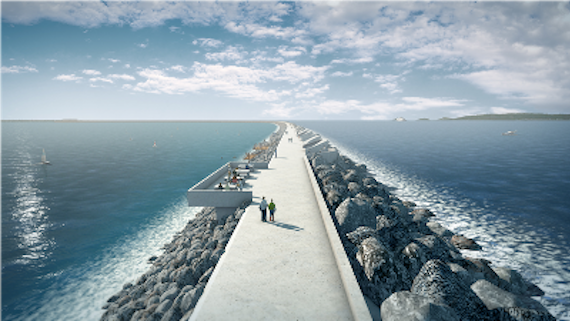Swansea Bay Tidal Lagoon
4 Rhagfyr 2013

The Swansea Bay Tidal Lagoon could generate a £300M spend in Wales, create 1850 jobs and support the creation of £173M of gross value added for Wales within its three year development phase.
That's according to a new report published by the University's Welsh Economy Research Unit, Cardiff Business School on the economic effects associated with the construction, development and operational stages of the Lagoon.
Key findings include:
- A capital investment of £756M of which £300M will be spent in Wales (40%);
- Potential additional output in Wales of £454M and £173M GVA in the three year development phase;
- Over £5M annual local spend during the operational phase;
- A further potential £1.5M-2.1M per annum GVA to be achieved through associated leisure opportunities;
- Approximately 5540 person years (1850 FTE) of diversely-skilled employment in Wales during the three year construction period;
- Creation of 60 long term operational jobs and up to 90 additional jobs linked to visitor spending.
Led by Professors Calvin Jones and Max Munday, the economic effects assessment is based on a model developed by the University to track the existing and potential economic impacts for Wales of different electricity generation technologies.
The proposed Swansea Bay Tidal Lagoon will be the world's first, purpose-built, tidal energy lagoon, capable of generating predictable, renewable electricity for over 120,000 homes for over 120 years.
It also aims to create jobs, support onshore regeneration, promote tourism, and even foster art, sport and healthy living.
Professor Jones said: "We estimate that the £300M of regional spending evenly spread over a three year development period starting in March 2015 will result in a total of an additional £454M of additional output in Wales. This means for every £1M spent in the region, an estimated further £0.52M of economic activity is supported. Around half of this, almost £223M, is in the construction sector, with manufacturing and production the next largest portion at £170m. We estimate around £34M of output in financial and professional services would be supported, largely comprising project management, planning and engineering activities."
Professor Munday added: "The focus of job creation and support in manufacturing and construction sectors is important in the context of current challenges facing the Swansea Bay and Welsh economies. In the Swansea case economic inactivity rates are relatively high at 29%, and with nearly 5,000 Job Seekers Allowance claimants in September 2013. In Wales as a whole, following the recession, manufacturing employment has fallen by over 40,000 people and with around 30,000 jobs lost in the construction sector. There are connections between jobs losses in the two sectors with poor performance in terms of construction output linking through to lower demands placed on elements of the manufacturing sector. Larger strategic projects such as Tidal Lagoon Swansea Bay integrating construction demand with local manufacturing inputs and new industry will be an important means of strengthening prospects in these important parts of the regional economy.
"Furthermore, it is important to note that Tidal Lagoon Swansea Bay is first of an expected network of projects and construction and manufacturing employment connected with this first build could possibly be used in future lagoon builds in Wales and elsewhere. In addition to this, Tidal Lagoon Swansea Bay will continue to have economic and employment benefits over the many decades of its operational lifespan."
Mark Shorrock, Chief Executive Officer, Tidal Lagoon Swansea Bay explains: "Swansea Bay will be the first in a series of developments in Wales and the wider UK such that supply infrastructure developed as part of this project could gain additional opportunities in the long term in serving a wider network of lagoon projects. We want to see a minimum 50% of Welsh content for our first tidal lagoon and will work with Welsh industry to ensure that the region capitalises on its first-mover advantage to serve subsequent tidal lagoon developments."
"We want to see the Swansea City region become the Supply Chain Hub for all tidal lagoons and are working up plans for a large scale assembly facility in the Swansea City Region. We want to build excellence in marine construction of turbine housings and secure all critical components for hydro turbines in the UK with the majority from Wales. We also want to build part of the generators in Wales. We have assembled a best-in-class consortium of UK and international industrial businesses to establish local production facilities and supply chains to serve Tidal Lagoon Swansea Bay and future developments. We are confident from our work so far with representatives of Welsh industry that Wales has the skills base, experience and scalability to serve a larger UK tidal lagoon industry."